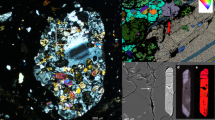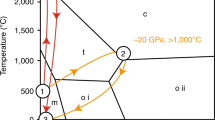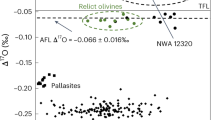Abstract
Invaluable records of planetary dynamics and evolution can be recovered from the geochemical systematics of single meteorites1. However, the interpreted ages of the ejected igneous crust of Mars differ by up to four billion years1,2,3,4,5,6, a conundrum7 due in part to the difficulty of using geochemistry alone to distinguish between the ages of formation and the ages of the impact events that launched debris towards Earth. Here we solve the conundrum by combining in situ electron-beam nanostructural analyses and U–Pb (uranium–lead) isotopic measurements of the resistant micromineral baddeleyite (ZrO2) and host igneous minerals in the highly shock-metamorphosed shergottite Northwest Africa 5298 (ref. 8), which is a basaltic Martian meteorite. We establish that the micro-baddeleyite grains pre-date the launch event because they are shocked, cogenetic with host igneous minerals, and preserve primary igneous growth zoning. The grains least affected by shock disturbance, and which are rich in radiogenic Pb, date the basalt crystallization near the Martian surface to 187 ± 33 million years before present. Primitive, non-radiogenic Pb isotope compositions of the host minerals, common to most shergottites1,2,3,4, do not help us to date the meteorite, instead indicating a magma source region that was fractionated more than four billion years ago9,10,11,12 to form a persistent reservoir so far unique to Mars1,9. Local impact melting during ejection from Mars less than 22 ± 2 million years ago caused the growth of unshocked, launch-generated zircon and the partial disturbance of baddeleyite dates. We can thus confirm the presence of ancient, non-convecting mantle beneath young volcanic Mars, place an upper bound on the interplanetary travel time of the ejected Martian crust, and validate a new approach to the geochronology of the inner Solar System.
This is a preview of subscription content, access via your institution
Access options
Subscribe to this journal
Receive 51 print issues and online access
$199.00 per year
only $3.90 per issue
Buy this article
- Purchase on Springer Link
- Instant access to full article PDF
Prices may be subject to local taxes which are calculated during checkout



Similar content being viewed by others
References
Chen, J. H. & Wasserburg, G. J. Formation ages and evolution of Shergotty and its parent planet from U-Th-Pb systematics. Geochim. Cosmochim. Acta 50, 955–968 (1986)
Nyquist, L. E. et al. Ages and geologic histories of martian meteorites. Space Sci. Rev. 96, 105–164 (2001)
Borg, L. & Drake, M. J. A review of meteorite evidence for the timing of magmatism and of surface or near-surface liquid water on Mars. J. Geophys. Res. 110, E12S03 (2005)
Bouvier, A., Blichert-Toft, J., Vervoort, J. D., Gillet, P. & Albarède, F. The case for old basaltic shergottites. Earth Planet. Sci. Lett. 266, 105–124 (2008)
Herd, C. D. K., Simonetti, A. & Peterson, N. D. In situ U-Pb geochronology of martian baddeleyite by laser ablation MC-ICP-MS. Lunar Planet. Sci. Conf. XXXVIII, abstr. 1664 (2007)
Niihara, T. Uranium-lead age of baddeleyite in shergottite Roberts Massif 04261: implications for magmatic activity on Mars. J. Geophys. Res. 116, E12008 (2011)
El Goresy, A. et al. Shock-induced deformation of Shergottites: shock-pressures and perturbations of magmatic ages on Mars. Geochim. Cosmochim. Acta 101, 233–262 (2013)
Hui, H. et al. Petrogenesis of basaltic shergottite Northwest Africa 5298: closed-system crystallization of an oxidized mafic melt. Meteorit. Planet. Sci. 46, 1313–1328 (2011)
Jagoutz, E. Chronology of SNC meteorites. Space Sci. Rev. 56, 13–22 (1991)
Brandon, A. D., Walker, R. J., Morgan, J. W. & Goles, G. G. Re-Os isotopic evidence for early differentiation of the martian mantle. Geochim. Cosmochim. Acta 64, 4083–4095 (2000)
Foley, C. N. et al. The early differentiation history of Mars from 182W–142Nd isotope systematics in the SNC meteorites. Geochim. Cosmochim. Acta 69, 4557–4571 (2005)
Lapen, T. J. et al. A younger age for ALH84001 and its geochemical link to shergottite sources in Mars. Science 328, 347–351 (2010)
Niihara, T., Kaiden, H., Misawa, K., Sekine, T. & Mikouchi, T. U–Pb isotopic systematics of shock-loaded and annealed baddeleyite: implications for crystallization ages of Martian meteorite shergottites. Earth Planet. Sci. Lett. 341–344, 195–210 (2012)
Krogh, T. E., Kamo, S. L. & Bohor, B. F. Shock metamorphosed zircons with correlated U-Pb discordance and melt rocks with concordant protolith ages indicate an impact origin for the Sudbury Structure. Geophys. Monogr. 95, 343–353 (1996)
Moser, D. E. et al. New zircon shock phenomena and their use for dating and reconstruction of large impact structures revealed by electron nanobeam (EBSD, CL, EDS) and isotopic U-Pb and (U-Th)/He analysis of the Vredefort dome. Can. J. Earth Sci. 48, 117–139 (2011)
Chamberlain, K. R. et al. In situ U–Pb SIMS (IN-SIMS) micro-baddeleyite dating of mafic rocks: method with examples. Precambr. Res. 183, 379–387 (2010)
Schmitt, A. K., Chamberlain, K. R., Swapp, S. M. & Harrison, T. M. In situ U–Pb dating of micro-baddeleyite by secondary ion mass spectrometry. Chem. Geol. 269, 386–395 (2010)
Nemchin, A. et al. Timing of crystallization of the lunar magma ocean constrained by the oldest zircon. Nature Geosci. 2, 133–136 (2009)
Sano, Y., Terada, K., Takeno, S., Taylor, L. A. & McSween, H. Y. Ion microprobe uranium-thorium-lead dating of Shergotty phosphates. Meteorit. Planet. Sci. 35, 341–346 (2000)
Gaffney, A. M., Borg, L. E. & Connelly, J. N. Uranium–lead isotope systematics of Mars inferred from the basaltic shergottite QUE 94201. Geochim. Cosmochim. Acta 71, 5016–5031 (2007)
Borg, L. E., Edmunson, J. E. & Asmerom, Y. Constraints on the U-Pb isotopic systematics of Mars inferred from a combined U-Pb, Rb-Sr, and Sm-Nd isotopic study of the Martian meteorite Zagami. Geochim. Cosmochim. Acta 69, 5819–5830 (2005)
Nimmo, F., Hart, S. D., Korycansky, D. G. & Agnor, C. B. Implications of an impact origin for the martian hemispheric dichotomy. Nature 453, 1220–1223 (2008)
Debaille, V., Brandon, A. D., Yin, Q. Z. & Jacobsen, B. Coupled 142Nd-143Nd evidence for a protracted magma ocean on Mars. Nature 450, 525–528 (2007)
Brandon, A. D. et al. Evolution of the martian mantle inferred from the 187Re–187Os isotope and highly siderophile element abundance systematics of shergottite meteorites. Geochim. Cosmochim. Acta 76, 206–235 (2012)
Neukum, G. et al. The geologic evolution of Mars: episodicity of resurfacing events and ages from cratering analysis of image data and correlation with radiometric ages of Martian meteorites. Earth Planet. Sci. Lett. 294, 204–222 (2010)
Johnson, C. L. & Phillips, R. J. Evolution of the Tharsis region of Mars: insights from magnetic field observations. Earth Planet. Sci. Lett. 230, 241–254 (2005)
Tornabene, L. L. et al. Identification of large (2–10 km) rayed craters on Mars in THEMIS thermal infrared images: implications for possible Martian meteorite source regions. J. Geophys. Res. 111, E10006 (2006)
Bogard, D. D. & Johnson, P. Martian gases in an Antarctic meteorite? Science 221, 651–654 (1983)
Head, J. N., Melosh, H. J. & Ivanov, B. A. Martian meteorite launch: high-speed ejecta from small craters. Science 298, 1752–1756 (2002)
Heaman, L. M. The application of U–Pb geochronology to mafic, ultramafic and alkaline rocks: an evaluation of three mineral standards. Chem. Geol. 261, 43–52 (2009)
Acknowledgements
We acknowledge the generosity of NWA 5298 donor D. Gregory. This project was supported by NSERC Discovery Grants to D.E.M. and K.T.T., a Wyoming NASA Space grant to K.R.C., an NSF EAR/IF grant to the UCLA SIMS laboratory, and postdoctoral funding to J.R.D. from the Government of Canada and the University of Western Ontario’s Center for Planetary Science and Exploration. We thank S. Swapp and N. Swoboda-Colberg for assistance locating and imaging SIMS targets, and I. Craig (University of Western Ontario) for graphics art support. We also thank L. Nyquist and A. Brandon for reviews of the manuscript.
Author information
Authors and Affiliations
Contributions
All authors contributed to this work. D.E.M., K.R.C. and K.T.T. designed the initial project. All authors conducted portions of either, or both, the fundamental field emission gun–scanning electron microscopy and SIMS data collection. A.K.S., K.R.C., D.E.M. and J.R.D. reduced the isotope data. D.E.M., I.R.B. and J.R.D. reduced the field emission gun–scanning electron microscopy data. D.E.M. wrote the main paper, and all authors discussed the results and commented on the manuscript at all stages.
Corresponding author
Ethics declarations
Competing interests
The authors declare no competing financial interests.
Supplementary information
Supplementary Information
This file contains Supplementary Figures 1-3 and Supplementary Tables 1-3. The Supplementary Figures collectively show the mineral textures surrounding a representative igneous martian microbaddeleyite from meteorite NWA 5298 (SF1, SF3), and an example of similar igneous CL zoning in a terrestrial baddeleyite crystal (Fig. SF2). The Supplementary Tables contain a) the settings used for EBSD analysis (Table S1) and b) the SIMS isotopic measurements of U and Pb in micro-baddeleyite (Table S2) and Pb in host phases (Table S3) in meteorite NWA 5298. (PDF 985 kb)
Rights and permissions
About this article
Cite this article
Moser, D., Chamberlain, K., Tait, K. et al. Solving the Martian meteorite age conundrum using micro-baddeleyite and launch-generated zircon. Nature 499, 454–457 (2013). https://doi.org/10.1038/nature12341
Received:
Accepted:
Published:
Issue Date:
DOI: https://doi.org/10.1038/nature12341
This article is cited by
-
Nano- and micro-structures in lunar zircon from Apollo 15 and 16 impactites: implications for age interpretations
Contributions to Mineralogy and Petrology (2022)
-
Oxygen Isotopes and Sampling of the Solar System
Space Science Reviews (2020)
-
Decline of giant impacts on Mars by 4.48 billion years ago and an early opportunity for habitability
Nature Geoscience (2019)
-
Atomic-scale age resolution of planetary events
Nature Communications (2017)
Comments
By submitting a comment you agree to abide by our Terms and Community Guidelines. If you find something abusive or that does not comply with our terms or guidelines please flag it as inappropriate.



